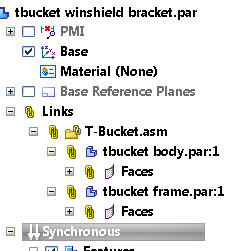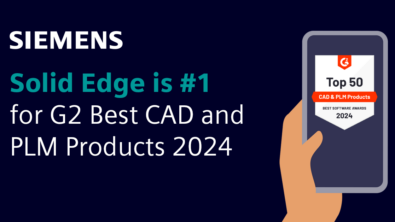Large Assemblies Part 2: Other Considerations

Another common source of performance problems comes from networks. The speed of your network is a separate issue that I won’t address here. That’s more of an IT infrastructure issue. But there are things you can do more in the CAD Admin vein that can greatly improve how your system performs when using networked files.
PDM
 My favorite solution is to avoid the network when you can. The best way to do that is to use a PDM system. If you have performance problems due to the use of file across a network, you need a PDM system. You don’t have to spend $50k to get a usable PDM system. Talking about selecting a PDM system is an entire series of blog posts that someone else will need to write, so let’s leave it at “you need a PDM system”.
My favorite solution is to avoid the network when you can. The best way to do that is to use a PDM system. If you have performance problems due to the use of file across a network, you need a PDM system. You don’t have to spend $50k to get a usable PDM system. Talking about selecting a PDM system is an entire series of blog posts that someone else will need to write, so let’s leave it at “you need a PDM system”.
The reason you need PDM is that the PDM vault is in a central location, but when you check files out to use them, they are copied down to your local machine in a way that doesn’t cause problems with duplication, overwriting, or permissions. That’s the kind of thing that the PDM system handles. So you get the advantage of working on shared files without the disadvantages of working on shared files. PDM is a no-brainer, and it will help with a bunch of other stuff, like your complicated rules aimed at avoiding overwriting someone else’s changes, revision control on solid models, and tons of confusing file management problems that PDM just sorts out naturally. Again, if you’re concerned about assembly performance, one of the first tools you need to get is some sort of simple PDM.
Draft
 One issue I didn’t really touch in the previous article was draft. If you think about what drawings have to do, it’s a lot of heavy lifting when it comes to large assemblies. You’ve got multiple views of large assemblies with a lot of parts, and maybe even cutaway, detail, or exploded views, so you’re showing your assembly in a lot of different states.
One issue I didn’t really touch in the previous article was draft. If you think about what drawings have to do, it’s a lot of heavy lifting when it comes to large assemblies. You’ve got multiple views of large assemblies with a lot of parts, and maybe even cutaway, detail, or exploded views, so you’re showing your assembly in a lot of different states.
You need to avoid interferences where possible to keep your drawings humming along. When your solid model has interferences, the display often looks like it has missing edges. Because it’s causing display issues, it is probably also spending more time calculating that bad display than it should. So make sure to check for interferences if you see wacky stuff in your assembly views.
Detail is great, and new 3D users sometimes get obsessed with how much detail they can create. You can make bolts look very realistic, right down to the grade markings on the head, and rounded edges, and textures, and highly detailed helical threads. Does all that detail mean that you’re more professional? No, it just means you’re maybe overly enthusiastic. Most of us have gone through that stage where we want to be as detailed as absolutely possible.
The problem with detail is that it is costly in several ways. First, detail takes a long time to create. Second, it takes a long time to display it every time you need to do so. We talked about this a little in the last article, but the problem really comes around to bite us again when you do drawings. Drawings have to calculate every edge, and then decide if they are hidden, shown, grayed out or dashed. For every part, every time it is shown. This really brings us to the big issue with performance all around:
Purpose
Each drawing, and each model behind the drawing has a single purpose or a set of purposes. What are you using the assembly for? What is the drawing used for? Is this just a concept model? Is it an inspection drawing? Is this a model you are going to use to create a complex injection mold from? How much drawing do you need to create a mold? Is there a difference between a manufacturing drawing and an inspection drawing?
Once you have answers to questions like these, then you can decide how much detail you need. You really may be able to get away with just showing bolt heads so that the head shape and drive are visible on assembly instructions, but you don’t really need to see the body length. Or maybe you need a shaded view for a visual inspection, but don’t need a full compliment of dimensions. CMM inspection has different requirements than a guy with a set of pins and calipers.
And then we could go down the “how do you represent tolerances on 3D models” discussion, but again, that’s something for a different time.
Using the right level of detail for the particular purpose of your assembly/drawing is all part of efficient use of resources.
More Performance Tools…
 Getting back on track with talking about performance, there are some additional tools you can use to help you manage the performance of assemblies. Limited Update and Limited Save can help you avoid wasting time with unnecessary compute and save time. The Solid Edge Help has a good description of how these tools work when parts are activated in-place in your assembly. Limited Update and Limited Save are available in the Assembly environment, on the Tools tab, Update group. They are usually smaller icons than shown here in the graphic. You’ll find them right next to the Update Active Level tools.
Getting back on track with talking about performance, there are some additional tools you can use to help you manage the performance of assemblies. Limited Update and Limited Save can help you avoid wasting time with unnecessary compute and save time. The Solid Edge Help has a good description of how these tools work when parts are activated in-place in your assembly. Limited Update and Limited Save are available in the Assembly environment, on the Tools tab, Update group. They are usually smaller icons than shown here in the graphic. You’ll find them right next to the Update Active Level tools.
And since we’re here, for smaller assemblies, it might not really matter if you activate all of the parts in the assembly or not, but it matters in large assemblies. You can use the PathFinder to help you see which parts are active and which are not (grayed icons are inactive, yellow are active). If all a part needs to do is “look pretty”, then inactive is the correct state. If you have to select it, use it, change it, then you need active parts. Activation is available from the RMB menu.
 Freezing links can also be an important way to prevent updates. To freeze links, you have to go to the Links collector at the top of the PathFinder in the individual part files. This will list all the links in the part, including Inter-part links, links from the Insert Part function, and variable links. Freezing links can be undone (unfreeze), but breaking links cannot be re-attached. The whole business about link management and when to freeze vs break is again, another (loaded) discussion on which we’ll have to embark at another time.
Freezing links can also be an important way to prevent updates. To freeze links, you have to go to the Links collector at the top of the PathFinder in the individual part files. This will list all the links in the part, including Inter-part links, links from the Insert Part function, and variable links. Freezing links can be undone (unfreeze), but breaking links cannot be re-attached. The whole business about link management and when to freeze vs break is again, another (loaded) discussion on which we’ll have to embark at another time.
Summary
Assembly performance isn’t all settings and simplification. There is a fair bit of higher level thinking you’ve got to do to really keep a large collection of data light on its feet. File management, detail/purpose, and link management are all important as well.



Comments